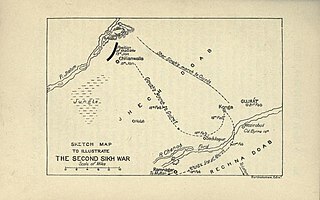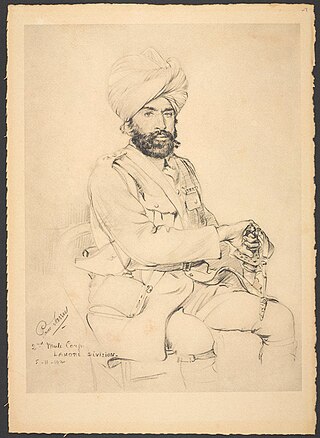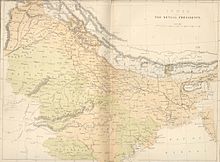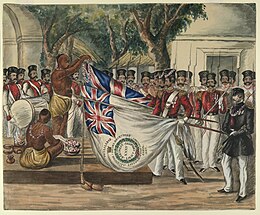
The second Anglo-Sikh war was a military conflict between the Sikh Empire and the East India Company which took place from 1848 to 1849. It resulted in the fall of the Sikh Empire, and the annexation of the Punjab and what subsequently became the North-West Frontier Province, by the East India Company.

The North-West Frontier was a region of the British Indian Empire. It remains the western frontier of present-day Pakistan, extending from the Pamir Knot in the north to the Koh-i-Malik Siah in the west, and separating the modern Pakistani frontier regions of North-West Frontier Province, Federally Administered Tribal Areas and Balochistan from neighbouring Afghanistan in the west. The borderline between is officially known as the Durand Line and divides Pashtun inhabitants of these provinces from Pashtuns in eastern Afghanistan.

The Battle of Sobraon was fought on 10 February 1846, between the forces of the East India Company and the Sikh Khalsa Army, the army of the Sikh Empire of the Punjab. The Sikhs were completely defeated, making this the decisive battle of the First Anglo-Sikh War.

The City of London Yeomanry (Rough Riders) was a yeomanry regiment of the British Territorial Army, formed in 1901 from veterans of the Second Boer War. In the First World War it served dismounted in the Gallipoli Campaign but reverted to the mounted role in the Senussi campaign, at Salonika and in Palestine. It ended the war as a machine gun unit on the Western Front. In the interwar years it was reduced to a battery in a composite Royal Horse Artillery unit in London, but in the period of rearmament before the Second World War it was expanded into a full regiment of light anti-aircraft artillery. It served in this role during The Blitz and later in the Tunisian and Italian campaigns. Postwar it became an armoured regiment. It amalgamated with the Inns of Court Regiment to form the Inns of Court & City Yeomanry in 1961. The lineage is maintained by 68 (Inns of Court & City Yeomanry) Signal Squadron, part of 71 (Yeomanry) Signal Regiment.
The Order of battle of the East African campaign shows the ground forces of both sides in East Africa on the date that the Italians declared war on Britain and France, 10 June 1940 and for the British and Commonwealth forces involved in the 1941 offensive.

The 7th (Meerut) Division was an infantry division of the Indian Army and before 1895, the Bengal Army, that saw active service during World War I.

The 3rd (Lahore) Division was an infantry division of the Indian Army and before 1895, the Bengal Army, first organised in 1852. It saw service during World War I as part of the Indian Corps in France before being moved to the Middle East where it fought against troops of the Ottoman Empire.
The Sussex Yeomanry is a yeomanry regiment of the British Army dating from 1794. It was initially formed when there was a threat of French invasion during the Napoleonic Wars. After being reformed in the Second Boer War, it served in the First World War and the Second World War, when it served in the East African Campaign and the Siege of Tobruk. The lineage is maintained by 1 Field Troop, 579 Field Squadron (EOD), part of 101 (London) Engineer Regiment (Volunteers).

The Hampshire Yeomanry was a yeomanry cavalry regiment formed by amalgamating older units raised between 1794 and 1803 during the French Revolutionary Wars. It served in a mounted role in the Second Boer War and World War I, and in the air defence role during and after World War II. The lineage is continued by 295 Battery and 457 Battery, batteries of 106 (Yeomanry) Regiment Royal Artillery, part of the Army Reserve.

The Bombay Army was the army of the Bombay Presidency, one of the three presidencies of British India.

The Madras Army was the army of the Presidency of Madras, one of the three presidencies of British India within the British Empire.

The structure of the Pakistan Army is based on two distinct themes: operational and administrative. Operationally the Pakistan Army is divided into nine corps and three corps-level formations with areas of responsibility (AOR) ranging from the mountainous regions of the north to the desert and coastal regions of the south. Administratively it is divided in several regiments. The General Headquarters (GHQ) of the Army is located in Rawalpindi in Punjab province. It is planned to be moved to the capital city of Islamabad nearby.

The 45th Rattray's Sikhs was an infantry regiment of the British Indian Army. They could trace their origins to the 1st Bengal Military Police Battalion raised in April 1856, at Lahore, by Captain Thomas Rattray originally consisting of a troop of 100 cavalry and 500 infantry. The initial class composition of the troops was 50% Sikhs and 50% Dogras, Rajputs and Mussulmans (Muslims) from the Punjab and the North-West Frontier. It is said that he went through the villages challenging men to wrestle with him on the condition that they had to join up. Whatever the case, the regiment was raised and trained and developed as an elite corps, which soon saw action in Bihar in the Sonthal 'parganas'. After sterling service in Bihar, Bengal and Assam, and during the 1857 Mutiny, the cavalry portion was eventually disbanded in 1864 and the infantry section was taken into the line of Bengal Native Infantry as the '45th Native Regiment of Infantry'.
In September 1939, the British Army was in process of expanding their anti-aircraft and mobile assets. Among these new changes was the formation of Anti-Aircraft Command which was formed on 1 April 1939, and the 1st Armoured Division formed in 1937. The list below will include the British Army units, colonial units, and those units which were in the process of formation.
6th Regiment, Royal Horse Artillery was a Regiment of the Royal Horse Artillery that acted as a training formation during World War II. It was the last RHA unit to serve in India between December 1945 and April 1947, before being redesignated as 6th Field Regiment, Royal Artillery in Palestine in 1948.
III Brigade, Royal Horse Artillery was a brigade of the Royal Horse Artillery which existed in the early part of the 20th century. It served with the 1st and 2nd Cavalry Divisions on the Western Front throughout World War I.
T Battery Royal Artillery is an air defence battery of the Royal Artillery that serves with the British Army's 12 Regiment Royal Artillery. It is stationed at Baker Barracks, Thorney Island, West Sussex.
The Order of battle, Keren 1941 shows Italian army forces that participated in the Battle of Keren from February to March 1941 and British troops in Sudan on 20 January 1941, which participated in military operations against Eritrea during the East African Campaign 1940–1941.





















